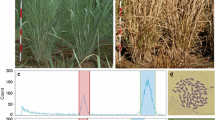Abstract
Restriction fragment length polymorphisms (RFLPs) were studied in fourteen accessions of CCDD genome allotetraploid wild rice species (Oryza latifolia, O. alta and O. grandiglumis). Fourteen nuclear RFLP markers previously mapped in AA genome-cultivated rice were used as probes. A phylogenetic tree, constructed by parsimony analysis based on RFLPs, grouped the accessions according to their geographic origin from Central or South America. Oryza alta, O. grandiglumis and one accession of O. latifolia grouped together as a subgroup, and our results suggested that the three taxa should be considered as populations of a single complex species. Duplicate loci, representing the two constituent genomes of the allotetraploid, were observed for most RFLP markers. By comparing RFLPs from the allotetraploids with those from a CC genome diploid wild species (O. officinalis), it was possible to detect RFLPs specific for both the CC and DD genomes of the allotetraploid. In inter-accession F2 populations, independent segregation of RFLP markers for CC and DD genomes was observed.
Similar content being viewed by others
References
Beckmann JS, Soller M: Restriction fragment length polymorphisms and genetic improvement of agricultural species. Euphytica 35: 111–124 (1986).
Chevalier A: Nouvelle contribution a l'étude systématique des Oryza. Rev Bot Appl Agr Trop 12: 1014–1032 (1932).
Feinberg AP, Vogelstein B: A technique for radiolabelling DNA restriction fragments to a high specific activity. Anal Biochem 132: 6–13 (1984).
Gopalakrishnan R, Sampath S: Taxonomic status and origin of American tetraploid species of the series Latifoliae Tateoka in the genus Oryza. Indian J Agric Sci 37: 465–475 (1967).
Heinrichs EA, Medrano FG, Rapusas HR: Genetic Evaluation for Insect Resistance in Rice. International Rice Research Institute, Manila, Philippines (1985).
Helentjaris T, King G, Slocum M, Sidenstrang C, Wegman S: Restriction fragment polymorphisms as probes for plant diversity and their development as tools for applied plant breeding. Plant Mol Biol 5: 109–118 (1985).
Hosaka K, Kianian SF, McGrath JM, Quiros CF: Development and chromosomal localization of genomespecific DNA markers of Brassica and the evolution of amphidiploids and N=9 diploid species. Genome 33: 131–142 (1990).
Jena KK, Khush GS: Embryo rescue and its scope in rice improvement. Rice Genet Newsl 1: 133 (1984).
Jena KK, Khush GS: Cytogenetic relationships among the three species of Oryza latifolia complex. Rice Genet Newsl 5: 74–75 (1988).
Jena KK, Khush GS: Monosomic alien addition lines of rice: production, morphology, cytology, and breeding behavior. Genome 32: 449–455 (1989).
Kam-Morgan LNW, Gill BS, Muthukrishnan S: DNA restriction fragment length polymorphisms: a strategy for genetic mapping of D genome of wheat. Genome 32: 724–732 (1989).
Katayama T: Cytogenetical studies on the genus Oryza. 3. Chromosome pairing in the interspecific hybrids with ACD genomes. Nippon Iden Zasshi 41: 317–324 (1967).
Kochert G, Halward T, Branch WD, Simpson CE: RFLP variability in peanut (Arachis hypogaea) cultivars and wild species. Theor Appl Genet (in press).
Landry BS, Kesseli RV, Farrara B, Michelmore RW: A genetic map of lettuce (Lactuca sativa L.) with restriction fragment length polymorphism, isozyme, disease resistance and morphological markers. Genetics 116: 331–337 (1987).
Maniatis R, Fritsch EF, Sambrook J: Molecular Cloning: A Laboratory Manual. Cold Spring Harbor Laboratory Press, Cold Spring Harbor, NY (1982).
McCouch SR, Kochert G, Yu ZH, Wang ZY, Khush GS, Coffman WR, Tanksley SD: Molecular mapping of rice chromosomes. Theor Appl Genet 76: 815–829 (1988).
Nayar NM: Origin and cytogenetics of rice. Adv Genet 17: 153–292 (1973).
Nezu M, Katayama TC, Kihara H: Genetic study of genus Oryza. I. Crossability and chromosomal affinity among 17 species. Seiken Ziho 11: 1–11 (1960).
Oka HI: Report of trip for investigation of rice in Latin American countries. National Institute of Genetics, Mishima, Japan (1961).
Saghai-Maroof MA, Soliman KM, Jorgensen RA, Allard RW: Ribosomal spacer-length polymorphisms in barley: Mendelian inheritance, chromosomal location and populations dynamics. Proc Natl Acad Sci USA 81: 8014–8018 (1984).
Sahi BB, Morishima H, Oka HI: A survey of variation in peroxidase, acid phosphatase and esterase isozymes of wild and cultivated Oryza species. Japan J Genet 44: 303–319 (1969).
Sampath S: The genus Oryza: Its taxonomy and species interrelationships. Oryza 1: 1–29 (1962).
Second G: A new insight into the genome differentiation in Oryza L. through isozyme studies. In: Sharma AK, Sharma A (eds) Advances in Chromosome and Cell Genetics, pp. 311–323. Oxford and IBH Co., New Delhi, India (1985).
Song K, Osborn TC, Williams PH: Brassica taxonomy based on nuclear restriction fragment length polymorphisms (RFLPs). 3. Genome relationships in Brassica and related genera and the origin of B. oleracea and B. rapa (Syn campestris). Theor Appl Genet 79: 497–506 (1990).
Southern EM: Detection of specific sequences among DNA fragments separated by gel electrophoresis. J Mol Biol 98: 503–517 (1975).
Swaminathan MS: Plant research and world agriculture. Plant Mol Biol Rep 4: 1–17 (1986).
Tanksley SD, Young ND, Paterson AH, Bonierbale MW: RFLP mapping in plant breeding: New tools for an old science. Bio/technology 7: 257–263 (1989).
Tateoka T: Taxonomic studies of the genus Oryza L. In: Rice Genetics and Cytogenetics, pp. 15–21. International Rice Research Institute, Manila, Philippines (1964).
Vaughan DA: The genus Oryza L. Current status and taxonomy. IRRI Research Paper Series 138: 1–21 (1989).
Wang ZY, Tanksley SD: Restriction fragment length polymorphism in Oryza sativa L. Genome 32: 1113–1118 (1989).
Author information
Authors and Affiliations
Rights and permissions
About this article
Cite this article
Jena, K.K., Kochert, G. Restriction fragment length polymorphism analysis of CCDD genome species of the genus Oryza L.. Plant Mol Biol 16, 831–839 (1991). https://doi.org/10.1007/BF00015075
Received:
Accepted:
Issue Date:
DOI: https://doi.org/10.1007/BF00015075




